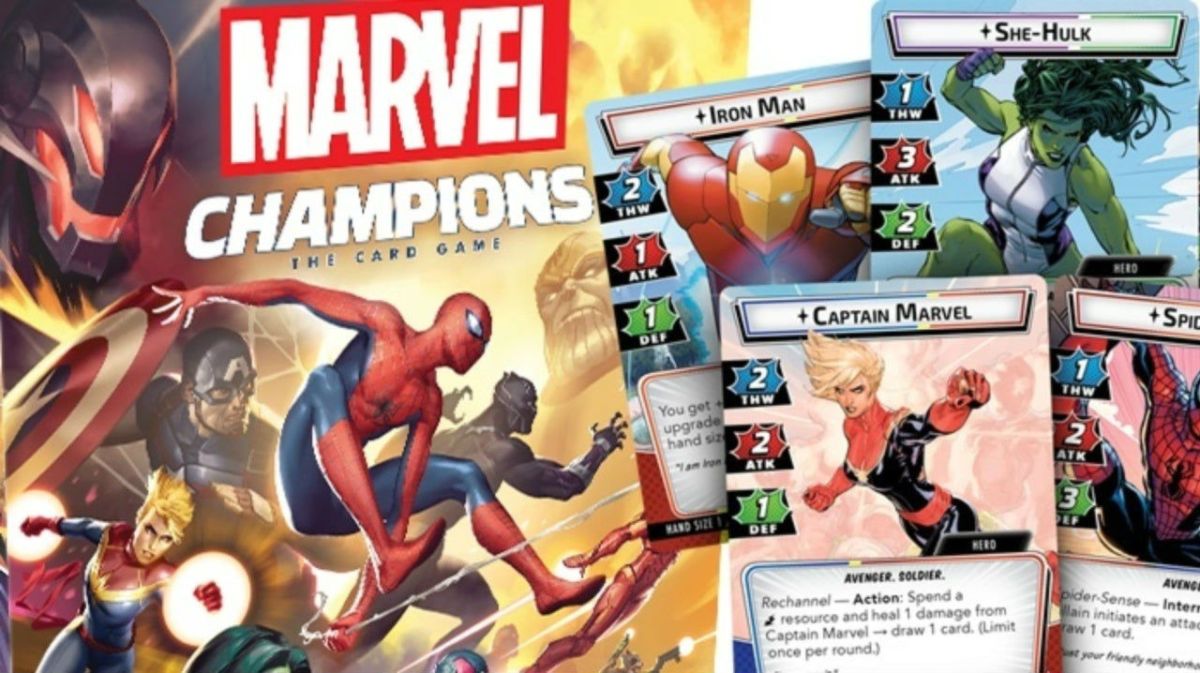LCG= ‘Living Card Game,’ or no blind packs
If you’ve been following my personal Game of the Year picks these past few years, you’re probably aware that I’m a big fan of the Lord of the Rings Living Card Game (LCG).
Although I do enjoy my Magic: Arena, I’ve cooled it a bit in the paper realm, mostly because of prohibitive costs (my local scene doesn’t play Penny Dreadful or Pauper, sorry!) and the idea of random blind packs. While singles purchases are an option, I vastly prefer the “you know everything you’re getting in each box” model of the LCG, not to mention the co-op angle of several of them (like LOTR).
Recently, LOTR LCG creator Fantasy Flight Games released Marvel Champions, and I’m all swept up in it.

First, a few primers.
The Marvel LCG is played in a co-op format of up to four players or as a solo affair. The core set (which retails for around $60 or less) includes five heroes (Spider-Man, Iron Man, Black Panther, Captain Marvel, She-Hulk) as well as the ability to create four different decks using one of the four aspects in the game (Aggression, Leadership, Protection, Justice). $60 is pricey in any context, but you can feasibly split it between four people and get a complete game.
To play you just need to build a deck using one hero and any aspect, and you’re good to go. Each hero has “must include cards” that are thematic (like Aunt May for Spider-Man’s deck) as well as obligations (bad things that can happen, like bringing out Vulture for the Spider-Man player, or force him to deal with apartment/real-life issues). Deckbuilding is much less strenuous compared to other LCGs, if that’s not your thing, but it will open up more over time as more cards enter the pool.
From there you choose a villain, which is your quest or mission. The core set includes Rhino, Klaw (Andy Serkis’ character from the Black Panther film) and Ultron, all of which have “expert” settings that swap in tougher versions of the villains. You can also swap in “modular sets” that mix up each mission, like having MODOK optionally come into the fray to help out Ultron.
Having played primarily in four-player mode, it’s an utter blast. Each turn is big, as you’re discarding cards from your hand to “pay” for other cards, all of which have an easy to read cost value on them. Your job is to stop the villain from scheming and beat them down by swapping between your alter-ego and hero forms, which are represented by double-sided cards. In other words, Peter Parker can use his genius to pay for extra cards and Spidey gear, then swap into Spider-Man and web kick Rhino. Tony Stark’s style is slow and steady, as his alter-ego excels at drawing up Iron Man armor upgrades, allowing him to change into his hero form to blast things up.
Theme is a big reason why I play the games I play, and so far each playstyle is a home run. She-Hulk smashes, Black Panther’s suit can absorb enemy attacks and redirect them and Captain Marvel flies around and blasts stuff. All three villains make their own mark on the game as well, and FFG is already hinting at some interesting encounters where you fight four villains at once (Wrecking Crew) or fight a villain with an alter-ego (Green Goblin/Normal Osborn).
It’s also playing right into Marvel’s hands when it comes to big-picture stuff. Upcoming hero releases include Ms. Marvel (Kamala Khan) and Thor, as well as villain packs for Green Goblin and the Wrecking Crew. FFG is aiming for monthly releases as of January. Ms. Marvel is going to be a big star in the upcoming Square Enix Avengers game. She-Hulk and Ms. Marvel have their own TV shows scheduled to debut on Disney+. Synergy!
Although competitive games are cash cows, I’ve really gravitated toward co-op games as I’ve gotten older. Nothing beats a game night with friends and beer. The Marvel LCG, like the Lord of the Rings LCG before it, satisfies that requirement in spades.

April 2021 update:
We were recently able to test the Galaxy’s Most Wanted (GMW) box, as well as the Scarlet Witch, Star Lord, Gamora, Drax, and Venom heroes, as Marvel Champions continues to evolve and shift.
Galaxy’s Most Wanted features five scenarios (Drang, Collector 1, Collector 2, Nebula, Ronan) and features a decidedly more hardcore tint to it. As time goes on the individual hero packs in the Guardians cycle have proven to be formidable, but Groot and Rocket (who are included in the box itself) may have some trouble taking on the more difficult scenarios. With that in mind, this cycle has been incredibly thematic and cohesive. It feels like the team is going all-out with the Guardians, potentially getting all of the their top hero and ally choices out of the way before they move on to the next theme (editor’s note: which we now know to be Thanos-themed).
The core concepts are pretty much the same as far as the aspect cards go, but several heroes have mixed things up considerably, as do the new Guardians box villains. While Drang is the most comfortable when it comes to mechanics, it does offer a look at how environments could drastically shift the framework of the game; something Ultron nailed in the core set. Both of the Collector scenarios are interesting, in that the first one “steals your stuff” and wins if there’s too much of it in the collection, and the second features a questing mechanic that’s very similar to the ever-popular Lord of the Rings LCG.
Nebula and Ronan are two of the toughest bouts yet, with a cat and mouse ship to ship mechanic and a knockout multi-attack fight respectively. You might need to bring out the big guns for them if you’re playing on expert, much less the expert campaign with the new challenge side schemes in the box. The campaign “market” (which allows you to buy cards to use in the GMW campaign) and the Badoon Headhunter module (who follows you and potentially gets stronger after each scenario) round out the box and add a little extra on top compared to the previous Red Skull campaign box.
Scarlet Witch is decidedly focused on chaos (discarding cards from the encounter deck for random effects), but she’s extremely powerful regardless of the initial fear of gambling (and one of my favorite heroes to date). Star Lord’s gimmick is hedging your bets to take more encounter cards (that do bad stuff) for a reduced cost on your own cards. Gamora slices and dices with combos that play off of attacking and thwarting (removing threat from schemes in play). Drax is all about getting angrier and angrier and stronger and stronger; which works far better than the previous attempt at a green rage-prone character. And Venom…he has tons of guns. And can do just about everything. And has symbiote minions built into his own set. Enough said.
Marvel Champions shows no signs of stopping, with Spectrum, Adam Warlock, and Nebula already confirmed; the latter of which is kicking off a brand new cycle. It’s been a blast to follow it monthly.

August 2021 update:
Speaking of! We were granted access to Mad Titan’s Shadow in August 2021, and it’s arguably the best box yet.
Spectrum and Adam Warlock are much stronger/more unique heroes than previous box offerings, with precons that actually feel tuned to standard, if not some expert scenarios. Spectrum in particular is a blast, as she’s constantly flipping between one of her three “forms,” which elegantly work with prior “form swapping cards” (notably in the Ant-Man and Wasp packs). Adam Warlock provides a “singleton” deckbuilding style, which, while inconsistent for higher difficulties sometimes, is very fun to jump into on standard, especially with the precon.
The scenarios are mostly all hits. Loki and Hela are the standouts, with the former bringing in some of that Lord of the Rings LCG magic in and building upon the Collector 2 scenario from the previous box. Loki feels like a true trickster when you’re fighting him, swapping between different forms and confusing you. The remaining scenarios of Ebony Maw, Tower Defense (Corvus Glaive + Proxima Midnight) and Thanos also all bring something to the table, and do it better than Galaxy’s Most Wanted.
As for the campaign itself, it’s a huge improvement. The team has managed to actually let the story elements sing inside of each scenario, instead of “appearing later” in the campaign unceremoniously (delay counters), or forcing a ton of in-between-match brain burn (Galaxy’s Most Wanted’s market). It only takes a few seconds to move from mission to mission now, and the campaign log is drastically shored up. I prefer this method of in-game storytelling and I hope it continues.





Published: Aug 16, 2021 12:15 pm